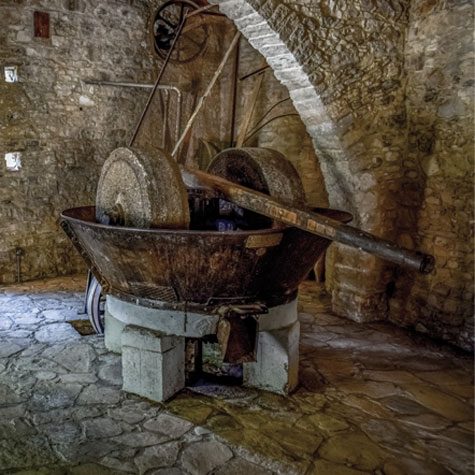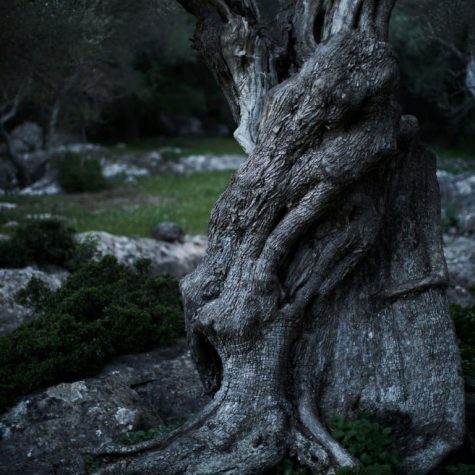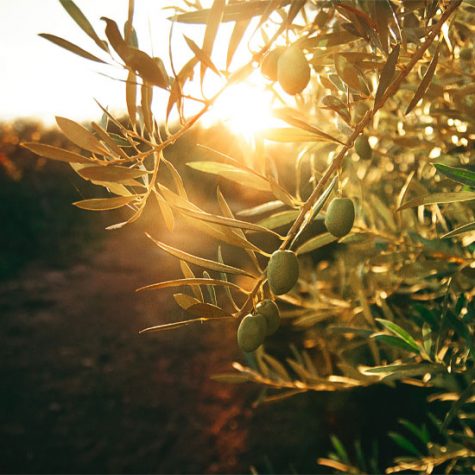Greece
is full of Olive Groves. The Olive Tree, “The Tree That Feeds The Children” according to Sophocles, is the protagonist of Greek nature and history as Olive Oil is the protagonist of the Greek Diet.
The indigenous Olive Tree (Wild Olive Tree) first appeared in the eastern Mediterranean but it was in Greece that it was first Cultivated, Since then the presence of the Olive Tree in the Greek region has been uninterrupted and closely connected with the traditions and the culture of the Greek People.
The olive has been deeply connected with Mediterranean history for millennia and has left its mark on the landscape and culture of The Mediterranean. The Olive Tree is a typical Mediterranean tree and is perfectly adapted to grow, bear fruit, and give its ‘Green Liquid Gold’ in the mild climate of the Mediterranean Region.
It is estimated that the cultivation of the olive commenced more than 7000 years ago. It has been proved that the Olive Tree has been cultivated in the eastern Mediterranean region (Crete) at least for 5000 Years.
The Olive Tree played a very important role in the island’s economy and may have been (Together With Shipping), one of the main sources of the wealth of the Minoan civilization (2000 To 1500 BC). With the decline of Minoan civilization and the Rise of the Mycenaean Civilization, cultivation passed over to the mainland of Greece and from there spread firstly to the Greek colonies in the Mediterranean Coastal Region. After the Roman Conquest of the Greek Empire, Olive Tree cultivation spread to the Southern And Western Mediterranean Coastal Regions.
With thousands of years of Evolution, the Olive Tree has adapted to cope with extreme conditions. These include drought, fire, poor soils, and even very low temperatures for short periods. Olive Trees can live for many years and carbon dating has revealed some to be over a thousand years old. One of the oldest Living Olive Trees in the world grows in Crete and is estimated to be more than 3000 years old. It has been growing and bearing fruit since biblical times and has been declared a National Monument. The olives produce are highly prized and a wreath made from its branches travels to the opening ceremony of each Olympic Games since The Athens Games in 2004.
Alongside the natural evolutionary process, the selection/breeding by mankind has produced several hundred cultivars of different forms and habits. Olive trees are now grown in many parts of the world from as far afield as the USA and New Zealand, with many varieties being suitable for growing in The UK. It is in the countries around The Mediterranean however, where The Olive Tree flourishes. It is the single most important economic plant in this region, with around 750 million trees in cultivation, no wonder The Olive Tree is the quintessential symbol of The Mediterranean Landscape.
Olive Oil was not only a valuable ingredient of the Greek Diet but also an important element of several medicines. Several philosophers, physicians, and historians mentioned its unique therapeutic properties, while several botanical classifications were made for ancient scientists to take the most out of the curative properties of Olive Oil. In the last decade, several scientists have started to Re-Explore these elements to further explore why the Mediterranean diet is so Healthy and Beneficial.
The Olive Tree also had a notable symbolic meaning in ancient times since it was apparent in several sectors of everyday life. A characteristic example is The Olympic Games, where the prize for the winner was an Olive Tree Branch symbol of armistice, Hostility, and Peace.
Olive Oil History In Greece
Greece has a long tradition in the production of qualitative Extra Virgin Olive Oil. The first recorded cultivation of Olive Trees worldwide took place in Greece, in the area of Create on 3500BC.
The reputation of Olive Oil was rapidly expanded all over Greece and it became a synonym for the Greek Diet. Today, valuable information about the ancient production of Olive Oil can be found in records discovered in the palaces of Mycenae and Pylos.

The Tree Of Life
This blessed tree flourishes in dry, stony Mediterranean areas with mild short winters and long hot summers, even under unfavorable conditions of drought, high winds, and Extreme Temperatures.
The Olive Tree is known as the “Tree Of Life” for its incredible endurance. Because Olive Trees can survive droughts and strong winds, and because of their resistance to diseases and unfavorable conditions, they can reach an age of over a thousand years. some Olive Trees in Greece, Italy, Palestine, and other Mediterranean countries are claimed to be from between 1000 to 3000 thousand years old. Olive Trees are more resistant to diseases and insects than any other fruit tree and therefore are sprayed less than any other Crop.

The Soul Of Greek Culture
The Olive Tree, its Fruits, and its juice are deeply and closely connected with Greece and the Greek soul and have had effects on cultural, social, and, economic life throughout its history. It was a principal commodity of the Greek Economy and an essential part of nutrition as far back as 1500 BC. Along with being an essential part of the Hellenic Diet, Olive Oil is a blessed product for the Greeks and has been used for medicine, cosmetics, lighting, heating, and religious ceremonies. The Olive, in particular in Greece, was and is a symbol of hope, peace, and victory. For the Greeks, the Olive Tree was and to some extent still is a Holy Tree.
A Protected Tree
The Greeks began to systematically cultivate the Olive Tree in the 8th century BC. Between the 7th and 3rd centuries BC, physicians and historians undertook its botanical classification and referred to the healing properties of Olive Oil and its History. It was Aristotle who elevated Olive cultivation to a Science. It is known that The Athenians introduced specific measures to protect The Olive Tree.
The first Olive protection law was introduced in the 5th century BC by Solon, the greatest lawmaker in Athens, prohibiting the cutting down of more than two trees a year in each Olive Grove. Destroying an Olive Tree was prohibited and any such action would be viewed as capital punishment by the Greek Court.

The Best Gift Of The Gods
During thousands of years of Greek history, many myths and legends have grown up around the Olive Tree. Greek mythology records that Athena, goddess of wisdom, art, and peace, brought the first Olive Tree, gave it as a gift to the city of Athens, and taught people to cultivate it and to use its fruits and juice.
According to the myth, the Greek gods Athena and Poseidon both competed for the favor of the largest and most influential city of the Time, but Zeus and the other Gods of Olympus devised a contest for them, specifying that the one that could provide the best and most useful gift to the people of the city would be chosen as its Patron.
Poseidon, the mighty God of the Seas, struck the ground with his trident and gave to the dry region a Fountain, but from him just flowed salt Water. Athena, the Goddess of Wisdom, thrust her spear into the ground of the rock of Acropolis and an Olive Tree grew up. The Gods, led by Zeus, decided that the Olive Tree, as a symbol of peace and agriculture, was a much better and useful gift than Poseidon’s saltwater Fountain, so Athena won the duel and became the Patron of The City of The Olive Tree. The city where the Olive Tree appeared and grew was named Athens in her Honour. Athena’s new tree, the Olive Tree, was a new immortal tree whose fruits and juice could be used as food or medicine or for beauty, for light, and its wood gave Warmth.
Since then, the Olive Trees were considered as ‘Holy’ and whoever cut down even one of these trees was banished to exile or even condemned to death. Local legend tells us that Athena’s original Olive Tree still grows after many centuries on the Ancient Holy Site.
